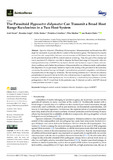Mostrar el registro sencillo del ítem
The parasitoid hyposoter didymator can transmit a broad host range baculovirus in a two host system
| dc.creator | Morel, Ariel | es_ES |
| dc.creator | Leigh, Brendan | es_ES |
| dc.creator | Muñoz Labiano, Delia | es_ES |
| dc.creator | Caballero Murillo, Primitivo | es_ES |
| dc.creator | Medina, Pilar | es_ES |
| dc.creator | Dáder, Beatriz | es_ES |
| dc.date.accessioned | 2023-08-01T13:33:45Z | |
| dc.date.available | 2023-08-01T13:33:45Z | |
| dc.date.issued | 2023 | |
| dc.identifier.citation | Morel, A., Leigh, B., Muñoz, D., Caballero, P., Medina, P., Dáder, B. (2023) The parasitoid hyposoter didymator can transmit a broad host range baculovirus in a two host system. Horticulturae, 9(2), 1-15. https://doi.org/10.3390/horticulturae9020170. | en |
| dc.identifier.issn | 2311-7524 | |
| dc.identifier.uri | https://hdl.handle.net/2454/45814 | |
| dc.description.abstract | Hyposoter didymator (Thunberg) (Hymenoptera: Ichneumonidae) and baculovirus (BV) might be used jointly to provide effective control of the Spodoptera genus. The literature has mostly covered the safe compatibility between natural enemies and BV-based insecticides, but research on the potential dispersal of BV by natural enemies is lacking. Thus, the goal of this manuscript was to ascertain if H. didymator was able to disperse the broad host range of Autographa californica nucleopolyhedrovirus (AcMNPV) to Spodoptera littoralis and Spodoptera exigua in choice and non-choice conditions and whether the preference of the parasitoid by one of these noctuids could mediate this dispersion. It was previously needed to improve the rearing of the parasitoid in the laboratory, concerning the optimal host age and length of parasitization, parasitoid competition, and influence of parasitization on the longevity of females. The best rearing conditions for S. littoralis are collective parasitization of mature L3 larvae for 24 h, after at least one day of copulation. Hyposoter didymator transmits AcMNPV to both lepidopterans, but its efficiency is mediated by host preference and the pathogenicity of the BV in each host. In this particular case, H. didymator as well as AcMNPV showed a clear preference towards S. exigua. | en |
| dc.description.sponsorship | This research was funded by MCIN/AEI/10.13039/501100011033, grants AGL2017-83498-C2-2-R, PID2020-117062RB-C22 and IJC2018-035042-I, and by Ministerio de Hacienda de Paraguay/Programa nacional de becas de postgrado en el exterior D. Carlos Antonio López, grant 01/2019. | en |
| dc.format.mimetype | application/pdf | en |
| dc.language.iso | eng | en |
| dc.publisher | MDPI | en |
| dc.relation.ispartof | Horticulturae 2023, 9(2), 170 | en |
| dc.rights | © 2023 by the authors. Licensee MDPI, Basel, Switzerland. This article is an open access article distributed under the terms and conditions of the Creative Commons Attribution (CC BY) license. | en |
| dc.rights.uri | http://creativecommons.org/licenses/by/4.0/ | |
| dc.subject | AcMNPV | en |
| dc.subject | Biological control | en |
| dc.subject | Noctuid | en |
| dc.subject | Spodoptera exigua | en |
| dc.subject | Spodoptera littoralis | en |
| dc.title | The parasitoid hyposoter didymator can transmit a broad host range baculovirus in a two host system | en |
| dc.type | Artículo / Artikulua | es |
| dc.type | info:eu-repo/semantics/article | en |
| dc.date.updated | 2023-08-01T13:30:13Z | |
| dc.contributor.department | Agronomía, Biotecnología y Alimentación | es_ES |
| dc.contributor.department | Agronomia, Bioteknologia eta Elikadura | eu |
| dc.rights.accessRights | Acceso abierto / Sarbide irekia | es |
| dc.rights.accessRights | info:eu-repo/semantics/openAccess | en |
| dc.identifier.doi | 10.3390/horticulturae9020170 | |
| dc.relation.projectID | info:eu-repo/grantAgreement/AEI/Plan Estatal de Investigación Científica y Técnica y de Innovación 2013-2016/AGL2017-83498-C2-2-R/ES/ | en |
| dc.relation.projectID | info:eu-repo/grantAgreement/AEI/Plan Estatal de Investigación Científica y Técnica y de Innovación 2017-2020/PID2020-117062RB-C22/ES/ | en |
| dc.relation.projectID | info:eu-repo/grantAgreement/AEI//IJC2018-035042-I | en |
| dc.relation.publisherversion | https://doi.org/10.3390/horticulturae9020170 | |
| dc.type.version | Versión publicada / Argitaratu den bertsioa | es |
| dc.type.version | info:eu-repo/semantics/publishedVersion | en |



